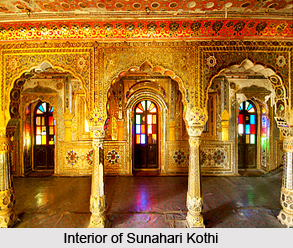 Tourism in Tonk district takes the visitors on a wonderful ride. There are a number of beautiful places of tourist attraction located in the district, most of them with a long historical tale to tell. Kothis, mahals and many more places of interest are found here, and are much-visited sites in all of Rajasthan. The Jama masjid found situated here is one of the biggest and most beautiful mosques in all of India. Other attractions include the Hathi Bhata, Rasiya ke Tekri, Bisalpur , Historical Ghanta Ghar and Shivaji Garden among others. The various places of tourism in the district of Tonk are discussed below.
Tourism in Tonk district takes the visitors on a wonderful ride. There are a number of beautiful places of tourist attraction located in the district, most of them with a long historical tale to tell. Kothis, mahals and many more places of interest are found here, and are much-visited sites in all of Rajasthan. The Jama masjid found situated here is one of the biggest and most beautiful mosques in all of India. Other attractions include the Hathi Bhata, Rasiya ke Tekri, Bisalpur , Historical Ghanta Ghar and Shivaji Garden among others. The various places of tourism in the district of Tonk are discussed below.
One of the biggest masjids in India, the Jama Masjid, is found located here in the district. It was started by the first Nawab of Tonk, Nawab Amir Khan in 1246 A.D and the construction was completed between 1297 A.D. and 1298 A.D by his first son Nawab Wzirudhoula. The four minars of this monument can be seen from a distance. Four big doors have been constructed in the masjid in the Mughal style. The main part of the monument resembles the Delhi and Agra Mughal style monuments. Golden paintings and Meenakari paintings can be seen adorning the walls.
The Sunahari Kothi is situated near Bada Kuwa on Najar Bagh road in Tonk city. Inside the Kothi, the walls have been beautifully made with a golden finish. Also known as the Shishmahal, one can see the diamonds, glasses, paintings, flowers, `Pachhikari` and `Meenakari` works adorning the walls. Rasiya ke Tekri, according to legend, is the place where a Kayasth lover used to sit and write love songs. On account of this romance (rasiya), this monument is called by the name of `Rasiya Ke Tekri`. Appointed by Raja Holkar, as a governor of this place Shri Ambaji Maharaj, a scholar, known for composing love songs, renovated Rasia Ki Tekri in 1859. About 22 Kms from the district headquarters, one can find the Hathi Bhata. It is a monument of an elephant carved out of a single stone. It was made by Ram Nath Slat during the regime of Sawai Ram Singh in 1200 AD. This evidence is written on the right ear of the elephant. This script can be read even today. The Historical Ghanta Ghar was constructed by Mohammad Sadat Ali Khan, Nawab of Tonk, in 1937. As per the local history, in 1936, the people of this place suffered from the Haiza disease. Nawab Sadat Ali Khan, 5th Nawab of Tonk, distributed medicines personally from house to house. Out of gratitude, the public presented money to him. This money was used to construct this particular monument. The Rajamahal is located along the banks of the Banas River. The palace is constructed on a big mountain at Kakor. This place is much frequented by national and international tourists. There is good heritage hotel that provides accommodation to the tourists. One can enjoy boating in `Dah of Salam Singh`. The Shivaji Garden is located in the Bhagat Singh Colony, Newai Town, about 30 Kms from Tonk headquarters. Its area is around 16 Bighas. It is a beautifully arranged garden, desingned along the lines of the Maisoor Gardens and the Hiran Magari Park. Beautiful musical gardens have been found arranged in this garden as also a swimming pool for children. Bisalpur is located about 70 kms from the district headquarters and 13 kms from Deoli tehsil head quarter. One can visit the beautiful Dam and historical Lord Gokarneswar temple situated here. As per the local history, Ravana had made `tapasya` here. The dam was constructed between two mountains on the Banas River. Here, the river splits the Aravali Mountain ranges. Its catchment area is 27,725 Sq. Kms.
Thus mentioned are the various places of tourism in the Tonk district of Rajasthan.



















